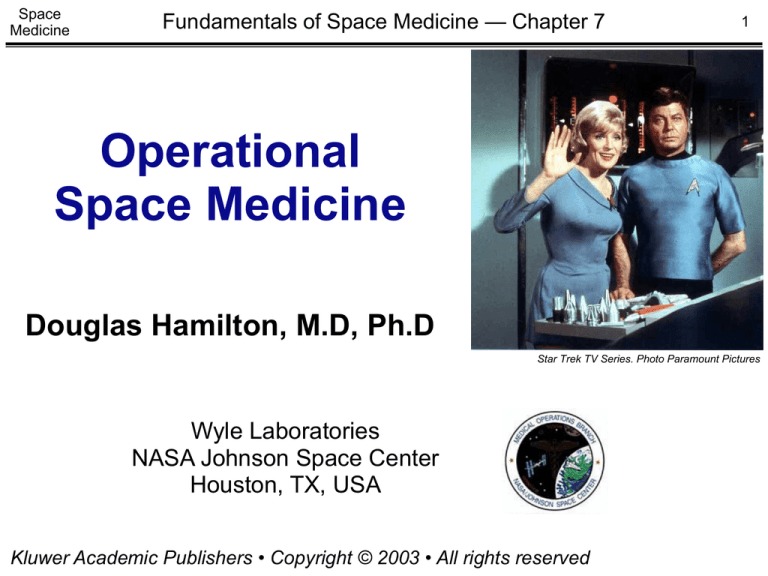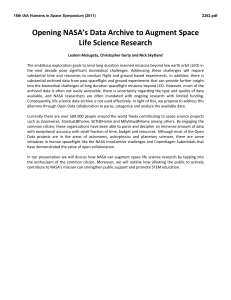
Space
Medicine
Fundamentals of Space Medicine — Chapter 7
1
Operational
Space Medicine
Douglas Hamilton, M.D, Ph.D
Star Trek TV Series. Photo Paramount Pictures
Wyle Laboratories
NASA Johnson Space Center
Houston, TX, USA
Kluwer Academic Publishers • Copyright © 2003 • All rights reserved
Space
Medicine
Key Concepts
• Space medicine: What is it?
• What are the health hazards of spaceflight.
Comparison with analog environments
• Medical selection of astronauts
and prevention of health hazards
• In-flight countermeasures
• Treatment of medical events in space.
The onsite medical facility.
Emergency and rescue
2
Space
Medicine
Space Medicine
3
• What it is
– It involves proactive and reactive care of humans to
optimize physical, physiological, and mental well-being, within
the unique constraints of an extreme environment
• What it isn’t
– Space Medicine is different
from Space Physiology
– Many aspects of adaptation to
weightlessness are
peculiarities, not necessarily
pathology
– Even if not pathological,
changes may alter the way a
disease presents or may
increase risks for a given
medical problem
Photo NASA
Space
Medicine
Space Medicine
“Your neuro-vestibular, cardio-vascular, and musculoskeletal systems can’t support you anymore.”
4
Space
Medicine
Operational Space Medicine
• Selection and Prevention are
the primary means of
maintaining crew health and
performance
• Countermeasures are used
when Selection and Prevention
are unable to mitigate the
deleterious effects of
spaceflight
• Treatment is used when
Selection, Prevention, and
Countermeasures are unable
to prevent or mitigate illness or
injury
• Rehabilitation: return to flight
status
5
Space
Medicine
History of Space Medicine
6
Photos NASA
Space
Medicine
Astronaut Selection
• Medical history
• Examination
– Physical exam
– Cardio-pulmonary
– Ear-Nose-Throat
– Ophtalmological
– Dental
– Neurological
– Psychiatric
– Radiographic
– Laboratory
• Others
– U.S.:
• Drug screen,
microbiological, pregnancy,
STD
– Russia:
• Decompression and
hypoxia
• Centrifuge for +Gz and
+Gx resistance
• Rotating chair
• Tilt table studies
• LBNP
• Heat stress
• Parabolic flight
7
Space
Medicine
Astronaut Training
8
Photo NASA
Emergency
egress
training
Jet
training
Photo CNES
Photos NASA
Medical training
Water
training
Space
Medicine
Risk Assessment
• Most tests have a poor ability for detecting the presence of
disease in very healthy individuals
• There are almost no tests which are designed to select-out
the occurrence of pathology (illness) over the next three years.
This is a problem for selecting a crew for a Mars Mission
• All risks cannot be predicted
Movie:
09_AlienSong
9
Space
Medicine
Common Medical Events
10
• Space Motion Sickness: count on 50-70%
• Foreign bodies in the eye: particles do
not “settle out”
• Decompression-related disorders:
especially with active EVA schedule
• Toxic inhalation: e.g. from
chemicals/reagents involved in
investigations, pyrolysis products
from fire, propellants
• Kidney stones: risk due to mobilization
of calcium from skeleton, and possibly
other factors
• Radiation: identified as the major
career-limiting exposure for astronauts
Photo NASA
Space
Medicine
Less Likely Medical Events
• Cardiovascular events: rigorous screening process during
astronaut selection, flight certification
• Major fractures: largely, forces which lead to such events
terrestrially, such as vehicle accidents and falls, not present
• Infectious disease: after a certain disease free “incubation
period” no new pathogens introduced into a small group
(however, there are also immune system changes with
unclear effects on overall risk)
Note: all the above represents a large portion of events
prompting visits to medical care facilities on Earth
11
Space
Medicine
Source of Ionizing Radiation in Space
• Solar energetic particles
emitted from the sun
during solar flares
• Particles trapped by the
Earth’s magnetic field in
the Van Allen belts,
• Galactic cosmic
radiation which crosses
the galaxy
Each of these sources
consists of all the types
of space radiation, but at
different energies and in
different relative proportions
12
Space
Medicine
Dose (Sv)
0.1-0.5
0.1-1
1-2
2-3.5
3.5-5.5
5.5-7.5
7.5-10
10-20
45
Acute Radiation Syndrome
Probable Medical Effects
No effects except minor blood changes
5-10% subjects experience nausea or vomiting,
fatigue for 1-2 days, slight reduction in white blood cells
25-50% nausea/vomiting, with some other symptoms,
50% reduction in white blood cells
75-100% nausea/vomiting, fever, with anorexia, diarrhea,
minor bleeding, 75% reduction in all blood elements.
5-50% subjects will die
100% nausea/vomiting, fever, bleeding diarrhea,
emaciation. Death of 50-90% in 6 weeks.
Survivors require 6 months convalescence
100% nausea/vomiting in 4 hours. 80-100% die
Severe nausea/vomiting for 3 days.
Death within 2.5 weeks
Nausea/vomiting within 1 hour.
100% die within less than 2 weeks
Incapacitation within hours. 100% die within 1 week
13
Space
Medicine
Radiation Exposure
• Exposure Limits for Ionizing Radiation
BFO
Eye
30 Days
0.25
1
Annual
0.5
2
Career
1-4*
4
14
Skin
1.5
3
6
*The career dose-equivalent (in Sievert, Sv) is based upon a maximum 3% lifetime risk
of cancer mortality. BFO: blood-forming organs
• Measured Radiation Dose during Spaceflight
Mission
Absorbed Dose(mGy)
Dose Equivalent (Sv)
Space Shuttle
2-4
0.005 Sv
(7-day mission orbiting Earth at <450 km)
Space Shuttle
5.2
0.05 Sv
(8-day mission orbiting Earth at >450 km)
Apollo-14
11.4
0.03 Sv
77.4
0.178 Sv
(9-day mission to the Moon)
Skylab-4
(84-day mission orbiting Earth at 430 km, 28.5 deg inclination)
Mir
146
0.584 Sv
(1-year mission orbiting Earth at 400 km, 51.5 deg inclination)
Space
Medicine
Radiation Shielding
15
• Effects of a Solar Flare Event with 2 g/cm2 shielding (Aug’72)
Time
06:21
13:00
14:00
15:00
16:00
17:00
Event
Optical flare observed
30-day limit exceeded for skin and optical lens
30-day limit exceeded for BFO; annual limit
exceeded for lens
Annual limit exceeded for skin
Annual exceeded for BFO; Career exceeded for lens
Career limit exceeded for skin
• Time to reach 30-day limit (hours)
Shield Thickness
0.2 (g/cm2)
1.0 (g/cm2)
5.0 (g/cm2)
BFO
6.0
6.3
8.9
Skin
3.0
3.5
8.0
Lens
1.9
2.4
6.5
Photo NASA
Space
Medicine
Rules in Space Medicine
16
• “Common things occur commonly”
• Mission-specific operational hazards: e.g., harmful environment,
toxic substances, etc.
• Injury / illness is occurring in a body which is adapting to
microgravity
• Manpower is in short supply
• In-flight, the crew is
on its own with limited
support from Earth
Photo CNES
Space
Medicine
Medical Hardware Selection
17
• Weight/volume: as small and
compact as possible
• Simple and intuitive to use; training
will be limited
• Power/data needs: add immensely
to complexity; non-powered if
possible
• Long shelf-life, "bullet proof”
technology desired
• Supports identified standards of
care; must meets clinical
management analysis, e.g. provides
useful information
• Modular, easy to replace and
upgrade components
• Think 0-G or partial G as needed
Photo NASA
Space
Medicine
ISS Crew Health Care System (CHeCS)
• Environmental
• Health Maintenance System
Health System
– Body Restraint System
• Countermeasures
– Cardiac defibrillator
– Advanced Life Support Pack
– Human Research Facility
• Gas Analyzer System
• Heart and vascular ultrasound
• Abdominal ultrasound, deep organ
• Gynecological ultrasound
• Muscle and tendon ultrasound
• Transcranial ultrasound
Movie:
18_lungs
18
First ultrasound
examination (lungs)
performed on board
the ISS.
Documents NASA
System
– Treadmill
– Cycle ergometer
– Resistive exercise
Space
Medicine
Examples of Flight Medical Hardware
• Cardiac Defibrillator / Monitor
Photo NASA
– Early electrical defibrillation correlates best with survival in
event of cardiac arrest (many roads to ventricular
fibrillation)
– It is no longer simple to apply force to defibrillator paddles;
adhesive conductive pads are used
– Must provide insulation from delivered voltage and
consider effects of electromagnetic interference (EMI) on
sensitive avionics
19
Space
Medicine
Examples of Flight Medical Hardware
• Advanced Life Support Pack
Photos NASA
– Accessibility and use strongly influence success / survival
– Medical waste, e.g., sharp needles must be carefully
disposed
– Medications must be tracked and discarded when shelf-life
exceeded
– Absorption of oral medications may be sensitive to
digestive function, which may be altered in space
– Alternate routes of administration may be better for some
drugs (intramuscular, intravenous, nasal)
20
Space
Medicine
Advanced Life Support Pack
Deployment and utilization of the Advanced Life Support Pack
on board the ISS
Movie:
21_contingency
Document NASA
21
Space
Medicine
Telemedicine
22
Injured or ill
Crewmember
Onboard Medical
Care Facility
Care Medical
Officer (CMO)
Telemedicine Link
Engineering
Support
Crew
Surgeon
Consultants
Space
Medicine
Telemedicine Pack
23
• Voice / video communications both ways (private medical
conferences, diagnostic and procedural aid)
• Continuous physiological monitoring (eases requirements
on crew; ground personnel can analyze trends)
• Video Imaging
– Eye
– Ear, nose, throat
– Skin
• Biomedical Monitoring
– ECG
– SpO2
– Blood pressure
– Heart rate
• Electronic Stethoscope
– Heart, lung, and bowel sounds
Photo NASA
Space
Medicine
Emergency and Rescue
• Response to an orbital medical event depends on 5 factors:
– Severity of illness / injury
– Capability of onboard medical system
– Ability of surgeon to assist during medical event
– Level of skill / training of onboard medical officer
– Ease / feasibility of medical evacuation to Earth
• Crew Medical Officer
– 3 -7 crewmembers on ISS
– Crew Medical Officer (CMO) on ISS is usually not a
physician
– CMO receives 40-60 hours of medical training completed at
least 3 months prior to flight
– Trained to recognize, treat, and stabilized acute injury
– Trained to prepare patient for transport
24
Space
Medicine
Treatment
• Treatment structure highly desirable
• Requires means of transporting
patient
• Necessary medical hardware in
proximity
• Restraint function integrated with
diagnostic and therapeutic systems
• Some new procedures need to be
adapted for microgravity (e.g., CPR)
Movie:
25_restraint
Documents NASA
25
Space
Medicine
Surgery in Space
26
• Operator and patient restraints
• Instrument deployment and
fixation
• Sterile environment
– Increased population of
antibiotic resistant bacteria
– Decreased immune function
documented in space
• Lighting and exposure
• Control of atmosphere
contamination (bleeding)
• Decreased proprioceptive
(muscle and skin) sensation
• Time delay for telesurgery
Photo NASA
Space
Medicine
Emergencies — Soyuz
Photos NASA
27
Space
Medicine
Emergencies — Egress
Photos NASA
28
Space
Medicine
Additional Reading
• Billica RD, Simmons SC, Mather KL, et al. (1996) Perception of the
•
•
•
•
•
•
medical risk of spaceflight. Aviat Space Environ Med 67: 467-473
Clément G (2003) Fundamentals of Space Medicine. Dordrecht:
Kluwer Academic Publishers
Lane HW, Schoeller D (eds) (1999) Nutrition in Spaceflight and
Weightless Models. Boca Raton, FL: CRC Press
Wilson WJ, Miller J, Konradi A, Cucinotta FA (eds) (1997) Shielding
Strategies for Human Space Exploration. NASA CP-3360
Washington, DC: NASA
Institute of Medicine (2001) Safe Passage: Astronaut Care for
Exploration Missions. Ball HR, Evans CH, Ballard JR (eds)
Washington, DC: National Academy Press
International Workshop on Human Factors in Space. Aviat Space
Environ Med 71, Number 9, Section II (Supplement) 2000
National Research Council (1996) Radiation Hazards to Crews of
Interplanetary Missions. Task Group on the Biological Effects of
Space Radiation. Washington, DC: National Academy Press
29

